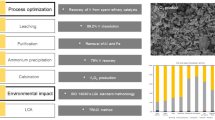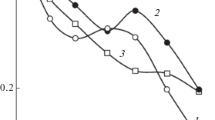The paper examines the technological properties of diverse vanadium-containing raw materials, including titanium-magnetite concentrate, converter slag, dump sludge, neutralization sludge, slag from ferrovanadium smelting, fuel oil ash and slag, black shale, and spent catalysts. The existing chains of their formation and processing are described, considering the volume of raw materials underutilized for vanadium extraction, such as blast furnace slag, tailings, ilmenite concentrate, red mud, vanadium slag, and titanomagnetite concentrates. Most of these materials prove suitable for vanadium extraction. According to our estimates, annually produced industrial raw materials involve approximately 53.6 thousand tons of vanadium relative to V2O5. This includes 4.4 thousand tons of V2O5 suitable for extraction and 12.0 thousand tons of V2O5 potentially suitable for extraction. Additionally, about 28.5 thousand tons of vanadium relative to V2O5, found in titanium magnetite concentrates and converter slag, could be further engaged in processing. Consequently, the reserve of raw materials unused for vanadium extraction amounts to 45 thousand tons relative to V2O5. Processing these raw materials holds the potential to manufacture vanadium-containing products of a deeper degree of processing, including purified vanadium pentoxide V2O5, vanadium trioxide V2O3, and vanadium alloys, thereby reducing dependence on imported equivalents.


Similar content being viewed by others
References
A. I. Volkov, “State and prospects of using rare metals in ferrous metallurgy,” Razved. Okhr. Nedr, No. 3, 11–18 (2020).
H. Peng, “A literature review on leaching and recovery of vanadium,” J. Environ. Chem. Eng., 7, 103313 (2019); https://doi.org/10.1016/j.jece.2019.103313.
F. Gao, A. U. Olayiwola, B. Liu, et al., “Review of Vanadium Production Part I: Primary Resources,” Miner. Process. Extr. Metall. Rev., 42, No. 3, 466–488 (2021); https://doi.org/10.1080/08827508.2021.1883013.
V. G. Mizin, E. M. Rabinovich, T. P. Sirina, V. G. Dobosh, M. E. Rabinovich, and T. I. Krasnenko, Complex Processing of Vanadium Raw Materials: Chemistry and Technology [in Russian], Ekaterinburg, UrB RAS (2005).
I. N. Monakhov, S. V. Khromov, P. I. Chernousov, and Y. S. Yusfin, “Element stream of vanadium in technological environment,” Metallurg, No. 8, 35–37 (2004).
Yu. S. Yusfin, T. N. Bazilevich, P. I. Chernousov, A. L. Petelin, V. I. Gubanov, and A. Ya. Travyanov, “New sources of raw materials for vanadium production,” Metallurg, No. 6, 29–30 (1998).
A. I. Volkov, U. A. Kologrieva, A. I. Kovalev, and D. L. Weinstein, “Influence of oxidation state and forms of elements in vanadium slag on its manufacturability,” Metallurg, No. 8, 42–46 (2019).
A. Volkov, U. Kologrieva, A. Kovalev, D. Wainstein, and V. Vakhrushev, “Vanadium chemical compounds forms in wastes of vanadium pentoxide production,” Materials, 13, No. 21, 4889, (2020); https://doi.org/10.3390/ma13214889.
A. I. Volkov, K. B. Osipov, P. A. Zhdanov, A. N. Seregin, and M. A. Bolshov, “X-ray fluorescence of vanadium slag following borate fusion,” Diagnos. Mat., 82, No. 1, 8–16 (2016).
C. O. Gomez-Bueno, D. R. Spink, and G. L. Rempel, “Extraction of vanadium from Athabasca tar sands fly ash,” Metall. Mater. Trans. B., 12, No. 2, 341–352 (1981).
C. Li, X. Zhou, H. Wang, et al., “Effect of oxidation on vanadium extraction from stone coal with calcified roasting,” J. Cent. South Univ. (Sci. Technol.), 42, No. 1, 7–10 (2011).
U. A. Kologrieva, A. I. Volkov, P. E. Stulov, and M. G. Mirakova, “Influence of preliminary heat treatment of vanadium sludges on their manufacturability,” Metallurg, No. 11, 69–74, (2020); eLibrary ID: 44416927.
U. A. Kologrieva and A. I. Volkov, “Investigating processing methods for lime sludge from drainage waters formed during hydrometallurgical production of vanadium pentoxide,” in: Tr. Kongr. Mezhd. Uchast. Konf. Mol. Uchen. “Fundamental research and development of processing and utilization of industrial formations:” TECHNOGEN-2019, Ekaterinburg, UB RAS (2019), pp. 564–565; eLibrary ID: 41562300.
U. A. Kologrieva, A. I. Volkov, A. S. Kirichenko, V. M. Ermolov, and M. G. Mirakova, “Development of a technological scheme for waste disposal formed during hydrometallurgical production of vanadium pentoxide,” Metallurg, No. 4, 78–82 (2019); eLibrary ID: 38095458.
N. L. Medyanik, A. V. Smirnova, Yu. A. Bessonova, and L. G. Kolyada, “Physical and chemical aspects associated with acid leaching of iron concentrate from titanomagnetite ore from the Volkovsky deposit,” Chern. Met., No. 6, 76–81 (2023); https://doi.org/10.17580/chm.2023.06.11.
A. Vishnyakov, “Vanadium and nickel recovery from the products of heavy petroleum feedstock processing: A review,” Metals, 13, 1031 (2023); https://doi.org/10.3390/met13061031.
A. Volkov, U. Kologrieva, and P. Stulov, “Study of forms of compounds of vanadium and other elements in samples of pyrometallurgical enrichment of ash from burning oil combustion at thermal power plants,” Materials, 15, No. 23, 8596 (2022); https://doi.org/10.3390/ma15238596.
A. I. Volkov and U. A. Kologrieva, “Investigating material composition of ash obtained during combusting heavy fractions of oil and natural bitumen as raw materials for vanadium extraction,” Probl. Chern. Met. Mater., No. 3, 27–36 (2021); eLibrary ID: 46632166.
Y. Wei, D. Li, J. Qiao, and X. Guo, “Recovery of spent SCR denitration catalyst: A review and recent advances,” J. Environ. Chem. Eng., 11, No. 3, 110104 (2023); https://doi.org/10.1016/j.jece.2023.110104.
Z. Chen, W. Chenye, W. Xingrui, L. Huiquan, C. Yan, and W. Wenfen, “Recovery of tungsten and titanium from spent SCR catalyst by sulfuric acid leaching process,” Waste Manage., 155, 338–347 (2023); https://doi.org/10.1016/j.wasman.2022.11.013.
M. Petranikova, A. H. Tkaczyk, A. Bartl, A. Amato, V. Lapkovskis, and C. Tunsu, “Vanadium sustainability in the context of innovative recycling and sourcing development,” Waste Manage., 113, 521–544 (2020); https://doi.org/10.1016/j.wasman.2020.04.007.
E. Romanovskaia, V. Romanovski, W. Kwapinski, and I. Kurilo, “Selective recovery of vanadium pentoxide from spent catalysts of sulfuric acid production: Sustainable approach,” Hydrometallurgy, 200, Art. No. 105568 (2021); https://doi.org/10.1016/j.hydromet.2021.105568.
D. Zhang, Y. Liu, Q. Hu, X. Ke, S. Yuan, S. Liu, X. Ji, and J. Hu, “Sustainable recovery of nickel, molybdenum, and vanadium from spent hydroprocessing catalysts by an integrated selective route,” J. Clean. Prod., 252, Art. No. 119763 (2020); https://doi.org/10.1016/j.jclepro.2019.119763
A. V. Maslov, G. A. Petrov, and E. Z. Gareev, “Low-carbon black shales of the Southern Urals and several regions of the Middle and Northern Urals: New data on geochemical characteristics,” Vestn. Perm. Uni. Geologoya, 16, No. 1, 48–60 (2017); https://doi.org/10.17072/psu.geol.16.1.48.
A. G. Samoilov, N. Yu. Zozyrev, and D. A. Shelepov, “Noble, trace, and non-ferrous metals in combustible shales of the Volga shale basin,” Izv. Saratov. Uni. Ser. Nauk. Zeml., 18, Issue 3, 194–197 (2018); https://doi.org/10.18500/1819-7663-2018-18-3-194-197.
I. A. Bogush, G. V. Ryabov, V. I. Cherkashin, and N. A. Isaeva, “Geochemical characteristics of ore-bearing black shales from the North Caucasus,” Geolog. Geofiz. Yug. Ross., 9, No. 3, 6–17 (2019). https://doi.org/10.23671/VNC.2019.3.36477.
I. V. Starostina, E. A. Pendyurin, and A. V. Tolitchenko, “Investigation of physical and chemical properties of sludge waste from ferrovanadium production,” Vestn. BSTU im. V. G. Shukhov, No. 1, 129–132 (2013).
K. V. Goncharov, D. Yu. Kashekov, A. S. Atmajidi, T. V. Olyunina, and G. B. Sadikhov, “Extraction of vanadium during processing vanadium sludge,” MiIRTEK, No. 3, 35–37 (2020); https://doi.org/10.26160/2618-8953-20193-35-37.
Yu. P. Kudryavsky, Yu. F. Trapeznikov, V. V. Strelkov, et al., “Hydrometallurgical processing of vanadium-containing waste,” Tsvet. Metallurg., No. 1, 25–29 (2000).
I. V. Vygovskaya, E. M. Rabinovich, L. L. Sukhov, and O. V. Belikova, “Studying the possibility of processing vanadium-containing ash from Lithuanian thermal power plants,” Izv. TulGU. Nauch. Osn. Resh. Prob. Metallurg. Proisv., Issue 2, 130–134 (2002).
A. S. Shapovalov, D. P. Chernykh, and O. V. Belikova, et al., Patent RF 2705844, IPC B22C7/02. 2011; Bul. 32 (unpublished).
A. N. Seregin, A. N. Butrimov, I. V. Gruzinsky, and V. V. Vdovin, “Technology for processing waste slag from ferrovanadium production,” in: Tez. Dokl. IX Vseross. Konf. “Chemistry, Technology, and Application of Vanadium,” Tula (2004), p. 89.
A. G. Krasheninin and D. P. Ordinartsev, “Pilot studies of hydrometallurgical processing of converter slags from the second stage of duplex process of vanadium cast iron to steel with vanadium extraction at Nizhniy Tagil Iron and Steel Works,” in: Tr. Nauch.-Prakt. Konf. Mezhdunar. Uchast. Shkola Mol. Uch. “Prospects for the Development of Metallurgy and Mechanical Engineering Using Completed Fundamental Research and R&D,” Ekaterinburg, UB RAS (2020), pp. 349–355.
D. Ordinartsev, A. Krasheninin, S. Petrova, et al., “Recycling of Vanadium-Containing BOF Slag with Agitation and Heap Leaching,” Metall. Mater. Trans. B., 53, 1162–1172 (2022); https://doi.org/10.1007/s11663-021-02408-y35.
V. V. Temnikov, E. G. Kalimulina, and B. S. Tleugabulov, “Analysis of the formation and processing of metallurgical waste at EVRAZ NTISW JSC,” Cher. Met., No. 7, 32–37 (2018).
V. P. Zaiko, V. I. Zhuchkov, L. I. Leontiev, et al., Technology for Vanadium-Containing Ferroalloys [in Russian], Moscow, Akademkniga (2004).
D. N. Abishev, Extraction of Vanadium from Blast Furnace Slags [in Russian], Cand. Tech. Sci. Dissertation, Alma-Ata (1966).
E. A. Korshunov, D. N. Gainanov, M. G. Ardashov, et al., Patent RF 2295582, IPC C22B34/12. 2007, Byul. No. 8.
F. F. Boriskov and D. F. Boriskov, Patent RF 2578876, IPC C22B34/12, 2016, Bul. No. 9.
A. V. Zakharov, O. M. Guman, A. B. Makarov, I. A. Antonova, and T. I. Li, “Environmental state of ferrous metallurgy disposal areas (based on the results of monitoring the NTISW slag disposal area),” Izv. Ural Gos. Gorn. Uni., No. 3(35), 51–56 (2014).
S. V. Bryzgalov, Reduction of Negative Impact of Blast Furnace Slags during their Disposal to Hydrosphere Objects [in Russian], Cand. Tech. Sci. Dissertation, Perm (2009).
S. P. Yatsenko, G. M. Rubinstein, and V. N. Diev, “Extraction of vanadium from solutions of alumina production,” in: Tez. Dokl. VII Vseros. Konf. (Mezhd. Konf. ) “Chemistry, Technology, and Application of Vanadium Compounds,” Chusovoy (1996), p. 81.
A. M. Kunaev, Pyro- and Hydrometallurgical Methods for Processing Vanadium Raw Materials in Kazakhstan [in Russian], Almaty, Nauka (1971).
P. E. Stulov, A. I. Volkov, A. F. Charkin, A. A. Fofanov, and A. Yu. Kuznetsov, “Obtaining ferronickel from spent catalysts of oil demetallization process,” in: Fundamen. Issled. Prikl. Razrab. Prots. Pererab. Utiliz. Tekhnog. Obraz.: Tr. VI Kongr. Int. Uchast. TECHNOGEN-2023, Ekaterinburg, UB RAS (2023), pp. 172–174; https://doi.org/10.34923/technogen-ural.2023.90.53.053.
V. Bobylev, A. Brodov, A. Fofanov, and E. Rabinovich, “Vanadium: reserves should last for centuries,” Met. Evras., No. 3, 88–90 (2001).
V. A. Salikhov, V. M. Strakhov, M. A. Volkov, and A. P. Grinyuk, “Reserve estimation for rare and rare-earth metals in coal waste from Khakassia, Buryatia, and Khabarovsk Krai,” Koks Khim., No. 6, 31–39 (2022).
U. A. Kologrieva and A. I. Volkov, “Development of hydrometallurgical technology for processing complex vanadium-containing raw materials,” in: Tr. Nauch.-Prakt. Konf. Mezhdunar. Uchast. Shkola Mol. Uch. “Prospects for the Development of Metallurgy and Mechanical Engineering Using Completed Fundamental Research and R&D,” Ekaterinburg, UB RAS (2020), pp. 320–322; eLibrary ID: 44133527.
Author information
Authors and Affiliations
Corresponding author
Additional information
Translated from Metallurg, Vol. 67, No. 9, pp. 101–112, September, 2023. Russian DOI https://doi.org/10.52351/00260827_2023_09_101.
Rights and permissions
Springer Nature or its licensor (e.g. a society or other partner) holds exclusive rights to this article under a publishing agreement with the author(s) or other rightsholder(s); author self-archiving of the accepted manuscript version of this article is solely governed by the terms of such publishing agreement and applicable law.
About this article
Cite this article
Volkov, A.I., Stulov, P.E., Kologrieva, U.A. et al. Study of Technological Properties and Processing Feasibility for Various Types of Vanadium Raw Materials in Russia. Metallurgist 67, 1379–1395 (2024). https://doi.org/10.1007/s11015-024-01630-8
Received:
Revised:
Accepted:
Published:
Issue Date:
DOI: https://doi.org/10.1007/s11015-024-01630-8




